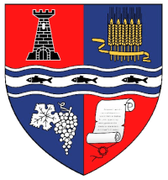Salonta
| Salonta Nagyszalonta | ||
|---|---|---|
| Municipality | ||
|
Peasant Museum | ||
| ||
 Location of Salonta | ||
| Coordinates: 46°48′0″N 21°39′0″E / 46.80000°N 21.65000°ECoordinates: 46°48′0″N 21°39′0″E / 46.80000°N 21.65000°E | ||
| Country |
| |
| County | Bihor County | |
| Status | Municipality | |
| Government | ||
| • Mayor | László Török (UDMR) | |
| Population (2002) | ||
| • Total | 18,074 | |
| Time zone | EET (UTC+2) | |
| • Summer (DST) | EEST (UTC+3) | |
| Climate | Cfb | |
| Website | http://www.salonta.net/en/fooldal.htm | |
Salonta (Romanian pronunciation: [saˈlonta]; Hungarian: Nagyszalonta, German: Grosssalontha; Turkish: Salanta) is a city in Bihor County, in the geographical region of Crișana, north-western Romania, near the Hungarian border.
Population
| Historical population | ||
|---|---|---|
| Year | Pop. | ±% |
| 1910 | 15,514 | — |
| 1930 | 15,297 | −1.4% |
| 1948 | 14,447 | −5.6% |
| 1956 | 16,276 | +12.7% |
| 1966 | 17,754 | +9.1% |
| 1977 | 19,746 | +11.2% |
| 1992 | 20,660 | +4.6% |
| 2002 | 20,006 | −3.2% |
| 2011 | 17,042 | −14.8% |
| Source: Census data | ||
According to the Romanian census from 2011, the city has a population of 17,042, made up of Hungarians (58.1%), Romanians (38.83%), Romani (2.4%), Slovaks 0.4% and others (0.5%).[1] In terms of religion, in year 2002, 51.12% were Reformed (Calvinist), 36.46% Romanian Orthodox, 6.56% Roman Catholic and 5.86% was split between Baptists, Romanian Greek-Catholic, Pentecostals and other faiths.[2]
History
The city, a part of the Kingdom of Hungary, was first documented in 1214 under the name of Zolonta and in 1332 a Papal document used the name Zalanta. From 1587 the Hungarian spelling Szalonta was used.
Until the 16th century, it was only a small village of about 300 inhabitants and was on the land of the Toldi family. A bigger city was the fort of Culiser, which was however destroyed by the Turks in 1598.
Culiser was never rebuilt and Salonta began to have a more important role in the region after 1606, when the prince of Transylvania, Stephan Bocskai settled 300 soldiers here and appropriated land for them. They built their own farms, but had to keep their arms ready to repel an attack by the Turks. 3 June, the day in which the soldiers were settled, is nowadays declared "the day of the city". However, Ottoman Turks captured the town in 1660 and as "Salanta", it became the sanjak center of Varat vilayet until 1692.
The 19th century Hungarian poet János Arany was born and lived in Salonta for most of his life. Lajos Zilahy, another noted Hungarian author, was also born in Salonta on 27 March 1891.
Salonta, along with all of Transylvania, became part of Romania with the 1920 Treaty of Trianon. From 1940 to 1944, as a result of the Second Vienna Award, it formed part of Hungary; after the Second World War, the Paris Peace Treaties reaffirmed the Trianon border.
Climate and geography
Salonta has a continental humid climate, with warm to hot summers and cold to very cold winters, but relatively little snow. The average annual precipitation is 578 cubic mm (35.2 inches).[3] The average January temperature is −2.4 °C (27.7 °F) and in July it is 20.7 °C (69.3 °F) (averages for low and high). It is located in the plains west of the Apuseni Carpathians at an elevation between 91 and 99 m (299 and 325 ft).
Economy
Salonta is famous nationwide for its Salam de Salonta sausage products that have been produced since the 1970s. Most of the state-owned factories built during the communist period went into bankruptcy since 1989. During the 2000s however, there has been a considerable foreign direct investment in small factories and assembly plants - particularly in the clothing industry.
In 2008, Inteva Products LLC - a large multinational - started production at its Salonta facility, the only one the company has in Romania and one in only five throughout Central and Eastern Europe. Inteva produces cables and latches and other car parts at the Salonta facility.[4]
Trivia
The city of Salonta hosted the 2006 Romanian National Gliders Championship (Campionat naţional de aeromodelism) and its team, Metalul Salonta, has won the championship several times.[5]
Politics
The Salonta Municipal Council, elected in the 2012 local government elections, is made up of 17 councillors, with the following party composition:
| Party | Seats in 2012 | Current Council | |||||||||||||
|---|---|---|---|---|---|---|---|---|---|---|---|---|---|---|---|
| Democratic Union of Hungarians in Romania | 13 | ||||||||||||||
| Social Liberal Union | 4 | ||||||||||||||
Image gallery
- Reformed Cathedral
- Orthodox Church
- Arany Janos High School
- The central park
- Train monument and the railway station
- The Peasantry Museum
- Consulate of Slovakia
International relations
Twin towns — sister cities
Salonta is twinned with:
 Csepel, Hungary
Csepel, Hungary Hajdúböszörmény, Hungary
Hajdúböszörmény, Hungary Nagykőrös, Hungary
Nagykőrös, Hungary Rimavská Sobota, Slovakia
Rimavská Sobota, Slovakia Sarkad, Hungary (since 2001)
Sarkad, Hungary (since 2001) Túrkeve, Hungary (since 1994)
Túrkeve, Hungary (since 1994) Derecske, Hungary
Derecske, Hungary Békéscsaba, Hungary
Békéscsaba, Hungary
References
- ↑
- ↑ Romanian 2002 Census
- ↑ NASA Langley Research Center Atmospheric Science Data Center; New et al. 2002, online,
- ↑ Reuters: Arvin Meritor in Salonta, Romania
- ↑ Romanian Aeromodelism, Salonta Cup
- NASA Langley Research Center Atmospheric Science Data Center; New et al. 2002, online, http://www.gaisma.com/en/location/salonta.html
- Romanian National Aeromodelism, Salonta Cup, http://www.salonta.net/en/files/etc/repulo.htm
External links
| Wikimedia Commons has media related to Salonta. |

